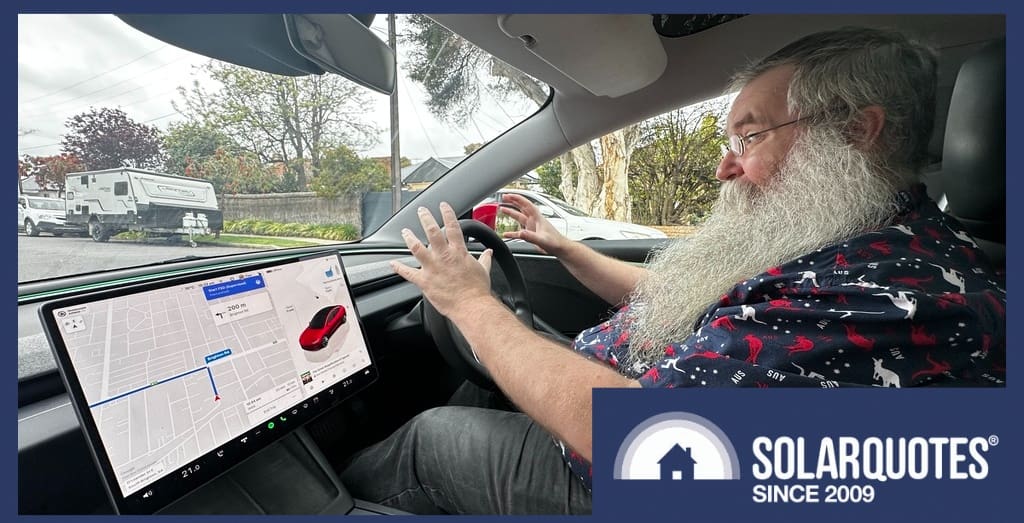
I don’t mind admitting that I was recently taken for a ride — by a robot car. Tesla Full Self Driving (Supervised) has arrived in Australia, and it took me for a spin.
I also don’t mind admitting it was pretty amazing. Sitting behind the wheel of a car that drove itself was exciting and frightening. It didn’t just drive like a dream; it was like three dreams, one after the other. First off, it was one of those dreams where you’re terrified for no good reason. Then it became a lovely dream as I overcame my apprehension. Finally, it was like one of those dreams I had as a kid after seeing The Terminator movie.
Is Tesla Full Self Driving Available In Australia?
Tesla Full Self Driving (Supervised) is now available in Australia and also Australia’s eastern bracket, New Zealand. These are the only countries it’s offered where people drive on the right side of the road, which is the left. If you want it, all you have to do is pay $10,100 extra when you buy a new Tesla.
The ability of some Tesla cars to drive themselves is often called Full Self Driving, but that’s not its real name. The correct term is Full Self Driving (Supervised), and yes, Tesla puts the word “supervised” in brackets like that. But because it can’t actually full self drive, it would have been more accurate to call it Full Self Driving (Not).
If it was full self driving, you’d be able to read a book, take a nap, play Fallout 4, eat lunch, or do whatever while the car drove itself without any need for intervention. But with Full Self Driving (Supervised), you have to pay attention at all times and be prepared to take over at any and every point. You are legally in control of the vehicle and there’s no getting out of traffic tickets or manslaughter charges by saying, “But my car did it!”
Even though it doesn’t live up to its name, the fact it can drive itself is still impressive.
I Had Reservations
When my boss Finn Peacock (an avid Tesla Full Self Driving enthusiast) told me the technology had arrived in Australia and asked if I wanted to give it a go, I immediately said, “Sure!” But this was because I didn’t want to show weakness (Finns can smell fear). I had to struggle to overcome some internal reluctance.
My main issue was Tesla seems way behind Waymo — the major North American company working with robo-cars. They’ve had nearly fully autonomous taxis operating in a limited areas for 5 years. Since they can remotely receive human assistance, perhaps they should be called Waymo Autonomous Taxis (Almost). From what I can tell, Waymo’s Full Self Driving (Almost) seems much more advanced than Tesla’s Full Self Driving (Not Really).
One of Waymo’s advantages is their cars use a combination of cameras and LiDAR, which is a type of short wavelength radar, while most Teslas get by with just 8 cameras to detect what’s around them. Teslas used to have radar, but they got rid of it. I know humans can drive without having radar or LiDAR, but that’s like saying bats fly without seat belts, so we shouldn’t put seat belts in planes. I know if I had the option of being able to blast radar waves out of my head, I’d definitely take it. I’m actually surprised Tesla hasn’t decided ditching radar was a mistake. My guess is they haven’t gone back to it because it would make Elon Musk look stupid. Or as I refer to him, CEO of Tesla (Stupider).
My final hesitation about trying Tesla Full Self Driving (Pull The Other One) was the car might not appreciate some of the things I’ve said about its name or Elon Musk and might hold it against me.
The App Was Crap
With Teslas, you can use a mobile phone app like a car key. The last time I drove Finn’s Tesla, it took us a while to get it going, but when it does work, it’s very convenient. But it didn’t work at all this time. Somehow, it entered a death loop, and nothing we tried got it going, so I ended up using Finn’s Tesla keycard.
To start with, I sat in the passenger seat while Finn got behind the wheel to show me how Full Self Driving (Not Really) worked. He had to back out himself because, unlike in the video that plays if you click on Full Self Driving (Supervised) on the Australian Tesla Site, when I was in the car, it always refused to robo-drive in or out of nose-in parking.
After that, the full self driving was engaged and it was amazing. Or at least, I could see that it was amazing, but on an emotional level, I couldn’t really accept that he wasn’t controlling the car. I felt like he must have been doing some kind of magic trick.
We went around a couple of blocks and arrived back at his place, where he got out and left me to my own devices, along with his big robo-car device. I was now in full control of letting the car take control.
A Heart Full Of Fear!
I will not hesitate to admit, when I sat alone behind that wheel, my heart was suffused with fear. There was only me and the robot and the certainty that at the end of this drive, only one of us would be alive. On account of how only one of us was alive in the first place.
As I prepared to place my health and safety in a robot’s cold steel hands, my body was one big ball of fear. (I know it looks like a big ball of lard in the picture at the top of this page, but trust me, it was all fear.) I was breathing hard, my nerves were on edge, and my muscles tense. I’m sure my heart rate was high, but I couldn’t hear it beating because all my attention was focused like a laser on the road around us. Focused like the laser detection system I was acutely aware the car lacked.
I told the car navigation system I wanted to go to IKEA — a Swedish restaurant with far too much furniture. I figured that was far enough away to be a decent test. My thumb hovered above the self drive button for several seconds before I was able to force it against the touch screen and we were off!
Once the robo-car and I were underway, I was shocked by how quickly my fear faded. I was recovering within minutes. My fear disappeared so fast it scared me. To show how quickly my fear faded, and how fast it came back at times, I’ll give each stage of my journey a terror level out of 10.
Note this terror level is simply a measure of how personally close I came to laying bricks and has nothing to do with politics. I know that 7 journalists, a few middle-aged protestors, and a guy in a chicken suit count as a full-blown terror alert to the current President of the United States, but this isn’t related to that.
First 5 Minutes: Terror Level 10/10
At first, it seemed wrong and unnatural. Surely the car couldn’t actually be driving itself! I had to fight the urge to grab the wheel and take control. I was painfully aware I would be held responsible for anything that went wrong and worried my reflexes wouldn’t be fast enough to take over if necessary. If I have to go to prison, I want it to be for crimes I commit and not as a robot’s patsy!
But the car didn’t do anything wrong. It indicated and drove away from the side of the road, heading down the street as smoothly and easily as if I was in full control. It wasn’t slow to accelerate, but not fast enough to be alarming. Then it came to a T-intersection and paused, waiting for a suitable gap in traffic to present itself. When one arrived, it pulled out without problem, and my tension began to drain away.
The Car Shows Caution: Terror Level 6/10
I don’t mean to boast, but I’m capable of remaining in a state of full panic for anything up to 20 minutes before I either relax (talking to people I don’t know) or go catatonic (quarterly meeting). But my extended panic capability wasn’t required, as I started to calm down within the first 5 minutes. By the 10 minute mark, the car had shown itself to be an effective driver. Not only did it refrain from doing anything dangerous, it took sensible precautions to avoid potential problems.
An example occurred when we were in the middle of three lanes, and the human driver on our right started drifting towards us. A fault human drivers often have is a tendency to move towards the lane they want to enter before they even indicate, often entirely subconsciously. As it drew closer, the Tesla indicated and moved into the lane on our left to get out of its way. If I had been driving, I wouldn’t have bothered. I would have simply relied on the driver of the other car being smart enough not to collide with us. The fact the robo-car was more cautious than I would have been was reassuring.
Robo-car Refrains From Peeling Out: Terror Level 4/10
Because the car displayed caution and changed lanes, we were now stuck behind a bus. I was interested to see what the car would do, and it did nothing. Or at least, nothing dangerous. I knew the Tesla had more than enough acceleration to pull out into the faster moving lane on our right, but it would have to really move to pull it off. To my relief, the car didn’t try anything — even though it could have — and we remained behind the bus, travelling at a sedate pace for a few minutes until it turned off. This was more reassuring evidence that the car was cautious and unlikely to do anything that would get me killed.
At one point, the cars in front of us stopped at an intersection, but instead of pulling up behind the car in front, the Tesla robo-car left enough space to leave the side street open so vehicles could get in and out. I appreciated it being a thoughtful driver.
Close, But No Cigar: Terror Level 5/10
While the car had done a good job of reassuring me it wasn’t in a hurry to get me killed, it did come closer to parked cars by the side of the road than I would have. This was probably a good thing, as it’s safer to be close to stationary cars that are almost always empty and unlikely to move, than to be close to moving cars containing unpredictable organic drivers with sensory and computing structures composed of fatty quivering jelly.
But each time it got close, it tended to refrazzle my nerves, because I knew there would be no way I could react fast enough to do anything about it in the period of time between, “It looks like we might clip the sideview mirror on that car” and “We’re going to clip the sideview mirror on that car!”
Fortunately, we avoided an encounter of the close kind on every occasion, but these close misses weren’t good for my equilibrium.
No Mercy For Snakes, Road Debris, Or Little Yellow Bumps: Terror Level 4/10
At around 15 minutes into the drive, I was feeling reasonably relaxed. I saw there was a strip of snake-like rubber on the road, which the car went straight over. But I would have done exactly the same, so it was no problem. But the vehicle doesn’t appear to have any ability to notice small obstacles on the road. They don’t even appear on the screen displaying what it “sees” around it.
Here’s a picture of the screen when stopped at an intersection:
While it may look as though the robo-car has a good idea of what’s going on, it’s less reassuring to watch in real time, as the vehicles displayed constantly change form, with sedans transforming into SUVs and trucks turning into buses, and then back again, as the car gathers information and tries to make sense of what’s going on around it. When it comes to details, it seems like me without my glasses on. Aware that other vehicles are there, but not too sure what they are.
However, it doesn’t have to “see” as well as a human does. It just has to avoid accidents as well as a human does. Or rather, better, since “Superior to human driving” is a far more effective selling point than “About the same as the average idiot on the road”.
The Tesla can see large speed bumps on the road, especially painted ones, and will slow down for them. But it does go over them faster than I would. This reduces the comfort of the ride, but I guess it gets you where you’re going a fraction of a second faster per bump.
But what it can’t see are little yellow speed bumps like these:
Or maybe it can see them and hates them so much it wants to hit every single one. Although it could be altruism that motivates it, and it’s trying to hammer them all into the road surface to protect the rest of us from having to deal with them.
Bus Chicken: Terror Level 8/10
You know how I said the car gets a little close to stationary cars by the side of the road? Well, the same applies to non-stationary buses coming towards you. We were at an intersection and turning right, while the oncoming bus was turning to their right, and for a short period, we were directly heading towards each other. The Tesla didn’t do anything technically wrong or illegal, but it did come closer to that bus than I would have. There was a brief moment when I was wondering if we were going to have crunchy contact, combined with the horror of knowing my quarter-of-a-second reaction time would be inadequate to prevent it. But it was fine. We missed by multiple centimetres. And the car’s upholstery was glad I took the precaution of eating a low-fibre diet the day before.
Navigation Is Fine: Terror Level 2/10
As we approached our destination, the car turned down a side street and took a route that I wouldn’t have, on account of it being longer. At the time, I wondered if it was stupid or if these streets were easier to self-drive on. But I later checked Google Maps, and it recommends going the way the Tesla chose because, while 200m longer, it’s generally quicker.
I’ll continue to take the direct route when I’m in an internal combustion vehicle to reduce fuel consumption and emissions by a tiny amount, but in an electric car charged with rooftop solar, there’s no real point in not taking the quickest way.
Can’t Park: Terror Level 1/10
We made it to IKEA without any impacts, which had a positive impact on my mood. Rather than park itself, the car slowly moved through the car park until I had to take control because it was about to drive over some low-set concrete marking the parking areas.
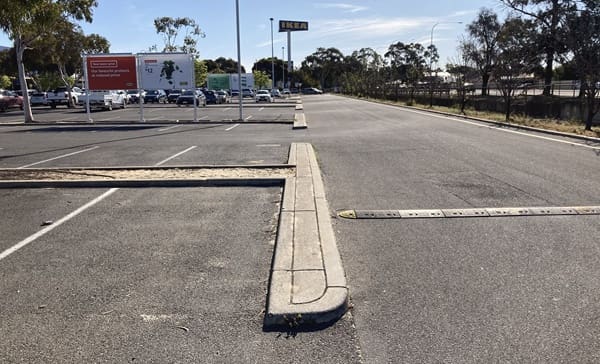
To survive the robot rebellion, I recommend disguising yourself as a concrete parking lot divider.
I had a brief rest in the car park, but didn’t get out in case the car decided not to let me back in.
Return Trip: Terror Level -1/10
As I headed back, I was way more relaxed. At first, I thought my fear had faded so fast because I was used to being a passenger, and this was similar. But, after a little thought, I decided it was because I was already used to driving on autopilot. But my own internal autopilot, rather than one running on silicon and code. Most of the time when I’m driving my Hyundai Getz, I have no awareness of what I’m doing. My body just drives automatically without my conscious attention. This may be why it took less than half an hour for self-driving to feel natural to me.
As we rolled down the road, in my relaxed state, I briefly pretended I was using psychic powers to control the car. But I decided that wasn’t a safe thing to do in case I decided to try to brake with my brain if a nun suddenly leapt in front of the car. Instead, I started to wonder what would happen when this kind of automation spread to all areas of life. Everyone wonders what it will do to work and human relationships, but what about animals? Some people think we’ll get robot pets, but I think we will get robots to keep our pets company because humans are weird. Will people marry robots? How come you never see a robot with a beard? If robots can grow beards and learn to tell bad jokes, will I be surplus to society’s requirements?
What The Hell Am I Doing?: Terror Level 11/10
At this point, I panicked, as I realised I had zoned out and had no idea whether or not my own personal autopilot had been monitoring the car’s autopiloting. I immediately checked the rear view mirror for run-over nuns but saw none. Either I hadn’t hit any, or I’d been zoned out for so long they were no longer in sight. While I like to think I was unconsciously paying attention and would have acted to prevent an accident if necessary, I have no way of knowing that.
The car does have a camera that watches you and is supposed to trigger an alert if it appears you’re not paying attention. But it has no way to know what’s going on behind my eyes. It can’t tell if I’m daydreaming away and looking at an entirely different world. And let me tell you, my daydreams can be pretty vivid. I’m the sort of person who prefers to read the book rather than watch the movie because the book will have better visual effects.
The natural human tendency to lose focus when not in direct control makes Tesla Full Self Driving (Supervised) dangerous, in my opinion. You might tell me that you always maintain focus in potentially dangerous situations and never let your attention wander, but I’d say that’s hardly relevant, as you’re clearly already a robot.
Final 5 Minutes: No Time For Fear
I didn’t go directly to Finn’s place, but instead parked by the ocean and took some pictures that made it look like a tree was growing out of the car. I had to do the hard work of exiting from the nose in parking myself, but after that, the car took over without problem.
We were going through some side streets and approached an intersection with a railway crossing directly to the left, which was the direction we wanted to travel. The boom gate was down while red warning lights flashed and bells rang. There was no other traffic around as the car came to a full stop and I thought, “Okay, we’re playing this safe.” Then the car started to move forward and turn to the left. I was a little surprised because there wasn’t enough room before the crossing for the car to straighten out, but I thought, “Okay, we’re committing ourselves to this turn…”
It was at this point the car tried to drive us under a moving train.
If a voice had come over the car’s speakers saying, “From Hell’s heart, I stab at thee!” I would have at least known it was personal and not something other people need to watch out for.
It’s possible the car would have stopped by itself, but by the time I hit the brakes, it had gone over the line — in more ways than one. If any police had been there to see it, I certainly could have copped a ticket.
You Can Nap While Your Car Drives – In The Future
As the car tried to commit suicide with me inside it by driving in front of a friend of Thomas the Tank Engine, I’m not entirely comfortable with recommending using Tesla Full Self Driving (Supervised). Not if you’re fond of living. As only around one hour passed between first meeting the robo-car and it trying to kill me, I don’t consider that as being safe enough. It’s particularly disappointing given that, while many humans may want to kill me within an hour, they can generally last at least two before making the attempt.
I realise I’m basing this recommendation on a single data point, but to me, this point of data is very large and personally significant. I know it’s bad form to allow sentiment to sway me like this, and I should allow the car to try to kill me around 30 times before I draw any firm conclusions, but this sort of behaviour is probably why you so rarely meet anyone who claims to be a statistician.
Unless you’re some sort of attention paying machine, I’d say the risk of losing focus and responding too slowly to danger is too great. I realise this may not impress those who paid over $10,000 for Tesla Full Self Driving (Supervised), but this doesn’t mean it won’t improve. In time, it may become safer than not using it. But I’d want independent confirmation of that. Don’t go believing what Elon Musk tells you. On the topic of self-driving cars, his word is about as reliable as that of, well… Elon Musk.
For SolarQuotes founder Finn Peacock’s perspective, read his column on Tesla’s self-driving technology and the backlash against Elon Musk.

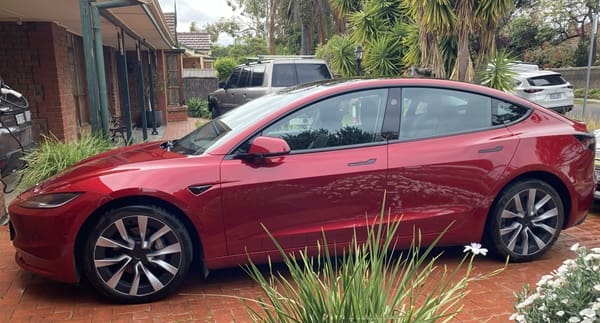
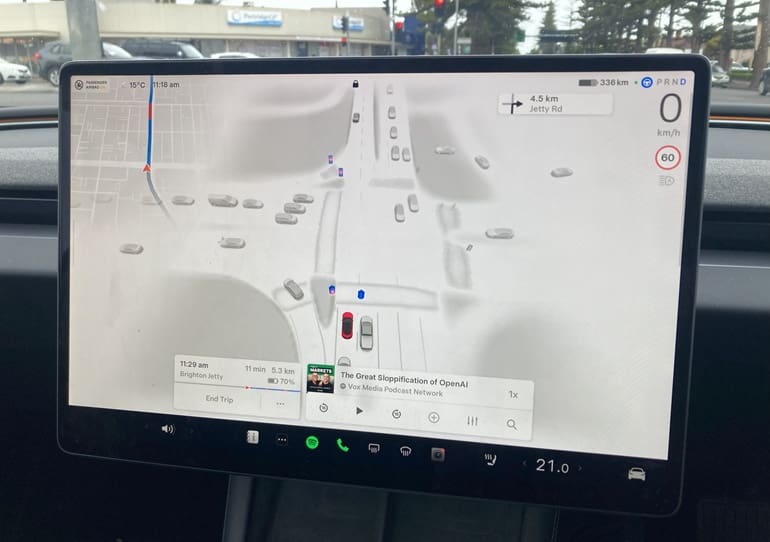

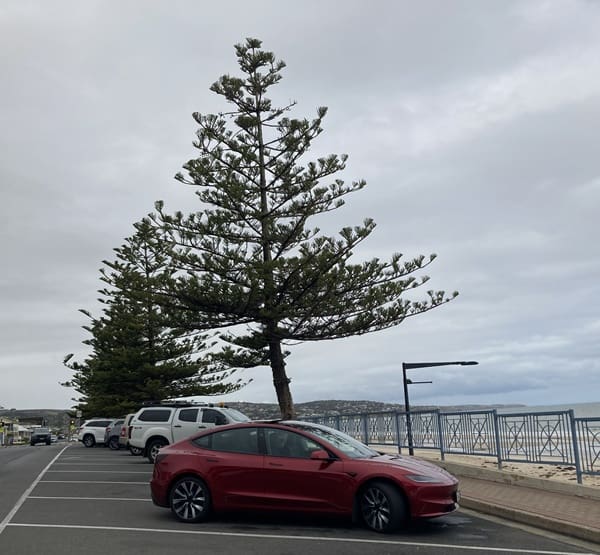
 RSS - Posts
RSS - Posts


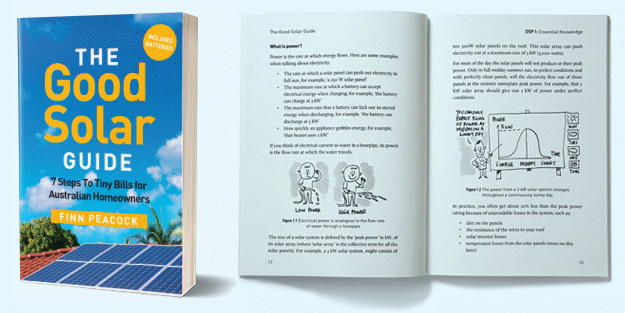
Wonderful review.
I think we hold autonomous driving technology to a much higher standard than human drivers. Humans are hopeless drivers, even those with the requisite skills can’t seem to employ them for more than 5 minutes without arbitrarily ignoring pesky things like speed limits.
I do a lot of driving. I’d feel a million percent safer on a road full of supervised self-driving vehicles. Just yesterday the car in front of me drove down the wrong side of the road. Human fully in charge.
I’m very optimistic about the future of self driving vehicles and their potential to almost eliminate road deaths. I’m just not sure how long it will be before fully autonomous driving takes off.
I’m not sure we even need full autonomy. What we have now with Tesla is like what pilots have on commercial airliners, making them enormously safer. That might do.
It would be nice to be able to take a nap. And without a system to monitor where the person in the driving position is sitting that ensures they are continually scanning the environment, with occasional tests to make sure they react in time, there are likely to be severe issues with people zoning out when they’re supposed to be ensuring the saftey of people in and out of the vehicle. It may be necessary to introduce a type of “shisa kanko” system for drivers, which is Japanese for “point & shout”. They use this to prevent train drivers and other workers in high risk activities from losing focus.
I think increasingly the shift will be to networking vehicles so that they’re aware of what other vehicles on the road are doing at the same time, rather than try to front-end all of it into very complex tech focused only on the individual driver.
Totally wrong!
There is not even a slight resemblance between airliners’ autopilot and Tesla’s FSD.
You should read more about aviation.
This is the problem with FSD: creates expectations which cannot fulfill, because a computer with visual cameras cannot replace a human driver with eyes and brain.
We will see that in the upcoming accidents made by Tesla cars with FSD!
I’ve discussed it with airline pilots. They’re pretty equivalent in terms of levels of automation, and in terms of what the role of the driver/pilot is in supervision.
Humans simply aren’t good drivers. They’re also not great pilots, for any length of time. Those who call themselves great drivers usually mean the ability to drive fast on public roads, which is the worst kind of driving.
You need not be terrorised- this is literally the very first RHD version in the world, and it will only get much better from here.
I have used it for a full weekend on a loaner vehicle and whist not yet perfect, it’s waaay better than half the other drivers on the road. None of the few errors I have seen were remotely dangerous, but rather just a bit frustrating with things like not getting in the far left lane soon enough for a left turn, (but you just help it by turning the left indicator on to encourage it to do the lane change earlier.) I have zero doubt that it’ll be better than almost any human drivers in no time at all, relatively speaking. It also doesn’t get tired, distracted, drug or alcohol affected, or suffer medical episodes- all of which can affect humans.
We can’t get it on our much older Tesla, but will certainly get it when we eventually update. P.S. You’re totally wrong about Waymo. It’s got HUGE limitations.
Glad for the insight into your experiences. But I’m afraid going terrorless wasn’t an option for me – at least not at first.
Hmmm, a dream is a dream – enjoy it- until it becomes a nightmare 🙂
We all have to go sometime, why not in a self driving coffin – I mean car 🙂
Driving through some roadworks the other day in an ordinary car we encountered some confusing roadworks where witches hats forced us to cross to the wrong side of the road and weave back and forth across lane markings. My car tugged at the wheel several times to alert me to the lane crossing without using the indicators. I thought at the time that an autonomous car would have great difficulty with this unusual situation. The camera system also has difficulty detecting temporary road works speed limit signs.
So … a situation where the human driver needs to take over.
I don’t see how being required to monitor the car while driving is any less stressful than actually driving the car yourself. More stressful from what I see.
I gotta agree with you on that one.
Ask a commercial airline pilot if having to monitor the plane on autopilot is more or less stressful than having to fly it manually the whole way.
(If they try to fly it manually the whole way, they’ll be fired.)
The airline pilots rely on autopilot, not because they are afraid to be fired or lazy. They do it because the aircraft is DESIGNED to be flown on autopilot. Also because the aircraft needs “trimming” which is a process of adjusting continously the flying surfaces (flaps, slats, ailerons, stabiliser, rudder) as a result of changing of the flying environment and center of weight of the aircraft.
There is no resemblance whatsoever between an autopilot and the Tesla FSD joke.
Because cars just go straight ahead and never need to adjust anything, and aren’t surrounded by thousands of other cars often travelling in close proximity travelling in different directions.
Autopilot in a plane is easier to engineer. Supervised autopilot is what both have.
What about pedestrians. How does it deal with them – respectfully? Fictional nuns don’t count.
From all the videos I have watched so far from all the Australian owners, it is extremely cautious with pedestrians, to a point that some people might find it way too cautious in this current iteration.
I saw Finn checking the bumper after I brought it back. He didn’t say anything so it must have been fine.
Okay, okay! There were no problems with pedestrians. It is able to detect them. But it still needs to be closer to things smaller than cars, such as cyclists and pedestrians, for them to appear on its screen.
The most wonderful thing about Tesla Full Self Driving Supervised is that this is the worst version of it that you would have ever experienced.
A quick call out in regards to Lidar. SpaceX uses Lidar extensively. If anyone who knows all about the strengths and weaknesses of Lidar, it would be Elon’s teams of engineers.
Lidar does not work in the rain. Lidar is noisy. When there is a clash between Lidar and Vision, which parameters should the AI Computer take to make its final decision ?
XPeng has also decided to use Vision exclusively for their upcoming version(s) of autonomous driving. A big nod to Tesla for sticking with the Vision only approach.
Here to the future and safe autonomous traffic!
Cannot for the life of me see the point of paying an extra 10K+ at purchase to have to sit in the drivers seat with your hands hovering over the wheel and brake foot at the ready however much of a novelty feeling this gives you. I enjoy my driving and if I need to somewhere chaotic with penalty parking without driving I take the train.
Depends how much driving is involved. I do long commutes every day, it’s bliss to be able to offload some of the cognitive and physical load after so many years. And watching the car drive is a new type of driving enjoyment, it’s control over the throttle for example is beyond what any human foot can do, in nuance.
Subscription will be available soon. This gives owners the flexibility to subscribe only when needed (e.g. a big road trip) instead of fronting up $10k.
I can’t believe Elon would be intending for people to ‘switch on / switch off’ FSD on a regular basis. I reckon it’s starting out relatively cheap now – $150 a month – but will soon go to $299 a month or $150 a month if you commit for 12 months or something like that.
I think it will come built in to the lease on the car.
If it can be independently shown that, under Australian conditions, just acting as a supervisor is safer than driving yourself – say if insurers offer lower premiums for supervised driving – then I’d feel better about using it.
I’ve not been surprised Tesla opted for a single technology. Integrating diverse visual inputs would be a nightmare in all sorts of ways, like trying to integrate water pipes and electrical lines.
If and when self driving does become the norm like the robo taxis in china and USA, sooo many people are going to be without a job i see a very dark future for a lot of people, most truck/driving jobs will be gone within next 5 years if it does become the norm, i think for the average tech nerd this is great but i think for the every day aussie its not much to get excited about, also electrical things can glitch and fail, i personally wouldnt feel safer with this tech, i have seen these systems glitch in china and they just drive in to random things, if the system does glitch who is to blame?
I understand why you might think this, but there’s a vast gap between supervised self driving and unsupervised on public roads. There will need to be so much long term data showing that unsupervised driving is DRAMATICALLY better than human drivers. I think Elon is hopeful of showing that Teslas only crash 0.5% of the time whereas human drivers crash 5% of the time (hypothetical numbers of course) but I don’t know that the public is going to accept robots that kill people under any circumstances, even if humans do it too. Humans have a tolerance for humanity, but not so much killing machines.
This might be the wrong place to ask but …
– How does it handle unlaned roads – I’m thinking of 2+ ‘lane’ roads with zero road markings to indicate where the vehicle should be placed, especially unlaned roads with rain pounding down to even further obscure things?
– How does it select which lane to travel in e.g. slow lane on left, overtaking lane on the right, a heavy truck chugging slowly uphill off in the distance while a RAM barrels along at top speed in the right lane, with ‘you’ having to decide whether to chug behind the truck, or swerve out in front of the pickup truck?
– How does it handle cows, pigs, deer, horses, kangaroos, camels, dogs, cats, and whatever else sometimes wonders across the road?
– Is FSD intended mostly for city driving?
As I say, SQ might be the wrong place to ask, but since I don’t expect anyone I know to get an EV, let alone FSD …
From the videos coming out of China, roads with no lanes are handled pretty well. FSD performs even better when there is an additional vehicle in sight.
The latest videos of v14.1.2 from USA pretty much answers all the rest of your questions.
🙂 maybe you are only seeing the vidoes they WANT you to see ?
It currently can’t handle complex roadworks. Anything that might make you have to pay close attention will tend to be too much for it. As for which lane to use, I found it chose safety over speed, which suited me, but it made no real difference to total travel time. I (fortunately) have no idea how it handles kangaroos, but given how they are most active in low light conditions, they are one of the reasons I think self driving cars should have LiDAR, as it may give a better chance of avoiding them. If it detects something moving that’s heading towards the road it will be cautious, but going by what appears on its screen, it doesn’t always pick up on what’s there as quickly as I’d like. Cities are a more complex driving environment than rural areas, but it can be used in both. Because rural areas are less complex to drive in (despite kangaroos) and have a have a higher death toll, Full Self Driving (Supervised) may have greater safety value there.
Actually the LiDAR or no matter would also pertain to the likes of the old Melbourne story where a narrow road with parked vehicles on at least the left side of the road had an Asian toddler bolt out in front of a slowly driving vehicle. Her father didn’t immediately realise she’d bolted but probably had a heart attack when he realised where she’d gone, lashing out at the car’s bonnet as he raced to grab her. No physical injuries as I recall, but if the car had been travelling faster, or the driver had slower reflexes …
Are rural areas less complex driving environments, or simply different driving environments? They often suffer extreme neglect from state governments resulting in badly maintained roads, critical upgrades are deferred for decades, and drivers do stupid things because of extreme frustration e.g. city tourists driving 10-20 kph below the speed limit with no legal and safe overtaking areas. I’m not convinced FSD would change much of this. Then again I’m a skeptic so …
I originally thought Tesla had made a mistake getting rid to LIDAR, but there realised that although it might make them a little slower to market, once it is working well their product will be much cheaper.
If the goal is to manufacture a huge number of cars and say they can later be made self driving, then leaving out the LiDAR represents a very large saving. But if every car is definitely going to be used for autonomous driving, then the cost of having LiDAR isn’t such a big deal. So Tesla’s business model definitely could have been a major factor in the decision.
“It was at this point the car tried to drive us under a moving train.”
If I had any doubts, this sentence clinched it for me. It’s 2025 and AI is going to the mat trying to convince users that there are three Bs in “blueberry”. It’s not ready to drive my car.
Frankly I don’t see the point at all if you need to focus 100% of your attention on watching it drive anyway.
I’ll check back in 10 years.
Ronald i am a retired professional driver (110/130000klm) annual 1 road rule i
have been picked up for rule 297 two hands on the steering wheel?
Iain Harley
Have anyone seen the “60 Minutes Australia” about Tesla self-driving? https://youtu.be/d_apmcDJGS8?si=w2a4s8NwVzzBcDYz
It looks like the FSD is far from being close to perfect and is being used as a tester on Australian roads.
The government is silent on regulating self-driving cars, so we are in a legal uncertainty.
The video is made using American accidents, but I think that soon we’ll have our own accidents.
Why anyone would want such abomination?
I don’t think the regulation at this stage needs to be amended. The driver needs to take responsibility, be in control of the car and be monitoring closely at all times as if they’re driving it themselves.
FSD is quite amazing, but also makes very basic mistakes, so it’s clearly not ready for any kind of green light for drivers to take less responsibility.
I don’t get it!
If it makes basic mistakes, why anyone wants to use it?
I can’t think of any other tool that we would want to use if would be so faulty or even dangerous to use!
Are we getting so lazy and careless?
Ummm, Cars are dangerous to use.
I have a chainsaw, but a mate of mine almost chopped his arm off with one. (As in, the cut went almost through his arm).
I was skiing with brothers wife when she had a fall and did an ACL.
Most new inventions were terrible when they first came out. The initial cars were much worse than a horse and carriage.
lol, why would anyone watch 60 Minutes? Was a hatchet job. I have FSD, works fine.
Well, I know a lot of guys who don’t watch Air Crash Investigation before flying, so I understand why you don’t want to watch 60 Minures about Tesla FSD.
It’s OK to defend your purchase… but don’t go into a cockpit (unless you are a pilot, but I doubt).
I wouldn’t let 60 Minutes walk my dog.
Interesting review
There is a online-UTube of drive.com.au
Going from north Sydney to Melbourne it an interesting watch.
The car did it by itself some 875km not perfect but the car did it. It’s a good watch.
My first “experiment” last Sunday with FSD (’24 Model 3) was somewhat frustrating – really slow (50km/h in a 70 zone), real “granny” driving. Naturally I sped up (normal Tesla mode!) & it settled into it, but it’s extremely conservative. Clearly, I need to read the instructions & have another go, but I’m not convinced…especially at $149 per month for a subscription. JP
Great review – mirrors my experience in using it too. I subscribed for a month on my 2024 Model 3 to try it out.
My observation is that it’s really quite boring driving with it – it’s like sitting in a taxi being driven by a very sedate taxi driver. It will happily dawdle behind buses (as you observed) and is in no particular hurry to get anywhere.
However, it makes plenty of mistakes — trying to go straight ahead from a right hand turning only lane, when it is clearly visualising the right hand turning arrow on its on screen depiction of the surrounds.
It doesn’t stop at stop signs properly and in compliance with the law — I follow the road rule of coming to a complete stop, whereas it seems to slow down a bit but roll through.
It doesn’t know how to handle turns through some less common median strip arrangements like one near me that has a turning lane with a bike path that goes through it, so you have to start the turn, stop and check for cross traffic and then continue.
Having read some of these comments, I don’t think I would like this.
I want either a reasonable part of my brain engaged, or nothing at all.
Great insight on FSD — it’s amazing and a bit nerve-wracking at the same time! Actually thinking about how it fits into a clean energy future: the tech behind the self-driving vehicle pairs nicely with innovations like a good solar battery system in the home. As we push toward smarter cars and smarter homes, storing sun-power in a solar battery matters just as much as the car driving itself.